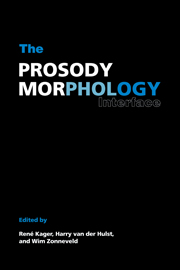Book contents
- Frontmatter
- Contents
- Contributors
- Preface
- 1 Introduction
- 2 On the moraic representation of underlying geminates: evidence from Prosodic Morphology
- 3 Verbal reduplication in three Bantu languages
- 4 Prosodic Morphology and tone: the case of Chichewa
- 5 Exceptional stress-attracting suffixes in Turkish: representations versus the grammar
- 6 Realignment
- 7 Faithfulness and identity in Prosodic Morphology
- 8 Austronesian nasal substitution and other NC effects
- 9 The prosodic base of the Hausa plural
- 10 Prosodic optimality and prefixation in Polish
- 11 Double reduplications in parallel
- Index of subjects
- Index of constraints
- Index of languages
- Index of names
4 - Prosodic Morphology and tone: the case of Chichewa
Published online by Cambridge University Press: 27 January 2010
- Frontmatter
- Contents
- Contributors
- Preface
- 1 Introduction
- 2 On the moraic representation of underlying geminates: evidence from Prosodic Morphology
- 3 Verbal reduplication in three Bantu languages
- 4 Prosodic Morphology and tone: the case of Chichewa
- 5 Exceptional stress-attracting suffixes in Turkish: representations versus the grammar
- 6 Realignment
- 7 Faithfulness and identity in Prosodic Morphology
- 8 Austronesian nasal substitution and other NC effects
- 9 The prosodic base of the Hausa plural
- 10 Prosodic optimality and prefixation in Polish
- 11 Double reduplications in parallel
- Index of subjects
- Index of constraints
- Index of languages
- Index of names
Summary
Introduction
The Bantu languages have provided interesting and important input on at least two major aspects of prosodic morphology. First, numerous Bantu languages such as Shona (Myers 1987), Chichewa (Kanerva 1990), Kinande (Mutaka and Hyman 1990), Ikalanga (Hyman and Mathangwane 1993), Kikuyu (Downing this volume) and SiSwati (Downing this volume) have been cited in support of bisyllabic or bimoraic minimality conditions on morphological operations. Second, in the area of reduplication, an increasing number of studies of Bantu languages have revealed a kind of theme and variations: they all seem to have something in common, but then they are all different. As elsewhere in phonology, the trend has been to reinterpret Bantu minimality and reduplication in nonderivational terms, particularly within Prince and Smolensky's (1993) rapidly developing Optimality Theory (OT). Thus, Carleton and Myers (1993), Downing (this volume), and others have made proposals as to how OT can be applied to basic facts of reduplication in Bantu languages. The assumption in all of this work is that a constraint-based approach to phonology will be at least as adequate and perhaps more insightful than analyses that might be proposed within a derivational model such as Lexical Phonology (Kiparsky 1982; Mohanan 1986). Of course the strongest kind of evidence in favor of non-derivational phonology would come from cases where the derivational approach runs into serious empirical difficulties. In Hyman (1993) the first author of this chapter showed that complications which arise in derivational models with extrinsic rule ordering do not appear if one adopts instead analyses with a “direct mapping” of one level of representation onto another.
- Type
- Chapter
- Information
- The Prosody-Morphology Interface , pp. 90 - 133Publisher: Cambridge University PressPrint publication year: 1999
- 18
- Cited by

